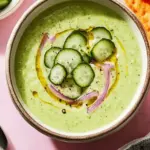The Chicken Schnitzel is a timeless classic, offering crispy golden edges and tender, juicy chicken on the inside. Inspired by the famous Wiener schnitzel, this version uses chicken breasts pounded thin and fried to perfection in a light breadcrumb crust. A quick spritz of lemon adds just the right amount of acidity to balance the rich, crunchy coating.
This dish is a weeknight winner that’s easy to prep and impressive enough for guests. Whether served alongside potato salad, coleslaw, or sautéed greens, it’s comforting, flavorful, and endlessly versatile. Make extra – leftovers make incredible sandwiches the next day!
Full Recipe:
-
2 boneless, skinless chicken breasts (about 1 1/2 pounds), trimmed of excess fat
-
1/2 cup all-purpose flour
-
2 large eggs
-
1/2 tablespoon German mustard
-
1 1/2 cups fine dry breadcrumbs
-
1 1/2 teaspoons salt, divided
-
Canola oil, for frying
-
1/2 lemon, cut into wedges, for serving
Directions:
-
Set up your breading station using 4 shallow bowls: flour in the first, whisked eggs with mustard in the second, breadcrumbs in the third, and leave the fourth empty for the finished cutlets.
-
Slice each chicken breast in half horizontally to create 4 thin cutlets.
-
Cover with plastic wrap and gently pound each cutlet to 1/8 to 1/4 inch thick using a meat mallet or pan.
-
Season cutlets with 1 teaspoon of salt.
-
Bread each cutlet: dredge in flour, dip in egg mixture, then coat in breadcrumbs, pressing gently to adhere.
-
Heat 1/2 inch of canola oil in a skillet over medium heat until it reaches 350°F (test with breadcrumbs—they should bubble immediately).
-
Fry the cutlets in batches for 2-3 minutes per side, spooning oil over the top as they cook.
-
Remove when golden brown and crisp, place on a wire rack or paper towels, and sprinkle with remaining salt.
-
Serve hot with lemon wedges.
Prep Time: 20 minutes | Cooking Time: 10 minutes | Total Time: 30 minutes
Kcal: 444 kcal | Servings: 4 servings
The Comfort and Craft of Chicken Schnitzel
Chicken Schnitzel is more than just a delicious, breaded piece of meat—it’s a comforting classic that transcends generations, borders, and trends. With its thin, golden crust and juicy interior, this humble dish represents a marriage of texture, flavor, and history. It’s both simple enough for weeknight cooking and impressive enough for a Sunday dinner. Whether you’re new to schnitzel or a seasoned fan, understanding its origins, variations, and best practices can elevate this dish from good to unforgettable.
A Brief History of Schnitzel
The term “schnitzel” comes from the German word Schnitt, meaning “cut.” Traditionally made from veal and known as Wiener Schnitzel, this Austrian national dish dates back to at least the 19th century and was often reserved for more celebratory meals. Over time, its popularity spread across Europe and into other continents, with countries like Italy (milanese), France (escalope), and Japan (katsu) creating their own culturally unique versions.
The chicken variation—what we know as Chicken Schnitzel—is a more accessible take on the original, especially popular in home kitchens where poultry is more affordable and widely consumed. Its preparation method remains rooted in tradition: the meat is pounded thin, coated in flour, egg, and breadcrumbs, and then pan-fried to crisp, golden perfection.
Why Chicken Schnitzel Works
What makes Chicken Schnitzel so special is its balance. Pounding the meat thin allows it to cook quickly and evenly, locking in the juices while developing a crackly, light crust. The breadcrumbs provide crunch without overwhelming the tender chicken inside. A splash of lemon juice added at the end cuts through the richness and brings brightness to the dish. It’s indulgent without being heavy—crispy but not greasy.
The visual appeal is also hard to resist. The thin, oversized cutlets with golden ripples and a light dusting of salt or herbs look elegant and rustic at the same time. It’s the kind of dish that feels both nostalgic and gourmet.
Variations Across Cultures
While Chicken Schnitzel is rooted in European cooking, its adaptability has allowed it to flourish in kitchens around the world. In Israel, schnitzel is a national staple often served in pita with pickles and hummus. In Argentina and other parts of Latin America, milanesa de pollo is a common comfort food served with mashed potatoes or rice. Even American diners and cafés have embraced schnitzel, often as part of fried chicken variations or hearty sandwiches.
One of the best things about schnitzel is its versatility. It can be made gluten-free by using alternative breadcrumbs. It can be customized with different seasonings or served with a wide range of sauces, from creamy gravies to sharp mustards. The cooking method remains the same, but the flavor profile can be adjusted to suit nearly any cuisine.
Serving Suggestions and Side Pairings
Traditionally, Chicken Schnitzel is served with lemon wedges and a simple side dish like German potato salad, cucumber salad, or buttered egg noodles. These accompaniments provide a balance to the crispy, savory meat without stealing the spotlight.
If you’re looking to modernize the presentation or suit specific dietary preferences, consider these alternatives:
-
Green salad with a vinaigrette: The acidity and crunch contrast beautifully with the fried exterior.
-
Coleslaw: Adds a creamy and refreshing element.
-
Roasted or mashed potatoes: Comfort food on comfort food.
-
Israeli-style: Stuff into pita bread with pickles, tahini, or hummus.
-
Asian twist: Serve it over rice with a soy-ginger sauce.
Chicken Schnitzel also holds up well for meal prep. Leftovers can be used in sandwiches or wraps, or sliced and added to salads. It’s delicious cold, too—a rarity for a fried dish.
Tips for the Perfect Schnitzel
Achieving schnitzel perfection requires attention to a few key details. Here’s what separates a soggy schnitzel from a sublime one:
-
Thinness matters: Pounding the chicken to 1/8 to 1/4 inch thickness ensures quick, even cooking. It also helps the crust develop that signature crispiness.
-
Season every layer: Season the chicken directly and lightly season your flour and breadcrumbs if you like. Every bite should be flavorful.
-
Use fine breadcrumbs: Classic schnitzel breadcrumbs are finer than panko and create a light, delicate crust that “puffs” as it fries.
-
Control your oil temperature: Keep the oil at around 350°F (175°C). Too cool and the schnitzel absorbs oil and becomes greasy; too hot and it will burn before the meat is cooked through.
-
Don’t overcrowd the pan: Fry in batches to keep the oil temperature steady and ensure even browning.
-
Serve immediately: While schnitzel can be kept warm in a low oven, it’s at its best fresh out of the skillet when the crust is at its crispiest.
Healthier Alternatives
While schnitzel is a fried dish by nature, there are several ways to make it lighter:
-
Air frying: Yields a crisp crust with minimal oil.
-
Baking: Spray lightly with oil and bake at high heat until golden.
-
Gluten-free crumbs: Use almond flour or rice-based breadcrumbs.
-
Lean protein: Use turkey or even tofu for a lower-fat or vegetarian version.
These alternatives might slightly alter the texture or flavor, but they make schnitzel more accessible for different dietary needs without losing its essence.
Why Chicken Schnitzel Belongs in Your Weekly Rotation
Quick, affordable, family-friendly, and universally loved—Chicken Schnitzel is one of those rare dishes that checks every box. It can be made on a whim with pantry staples, dressed up for guests, or reinvented in dozens of ways. It’s forgiving to cook and doesn’t demand fancy equipment or rare ingredients.
It’s also an excellent dish to teach young or novice cooks. The process of pounding, breading, and frying helps build kitchen confidence and imparts important cooking techniques like shallow frying and breading in sequence. Plus, the results are so satisfying it often becomes a lifelong go-to.
Conclusion
Chicken Schnitzel is a testament to how simplicity, when done right, can deliver extraordinary results. Its roots in European tradition, combined with its global adaptations, make it both a culinary staple and a cultural chameleon. Whether you’re honoring tradition with a German potato salad or adding a modern spin with coleslaw and air frying, Chicken Schnitzel is the kind of dish that evolves with you.
Beyond its irresistible crunch and comforting flavor, schnitzel offers something deeper—a sense of shared experience. From busy parents cooking weeknight meals to chefs elevating it on modern menus, everyone finds something to love in this golden, pan-fried classic. So grab your skillet, your meat mallet, and your breadcrumbs—it’s schnitzel night, and it’s going to be delicious.






